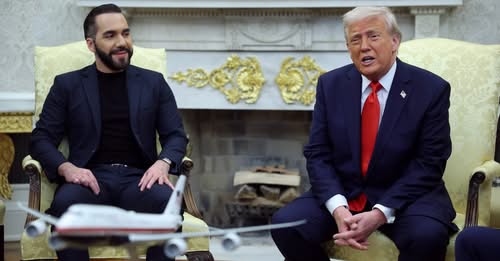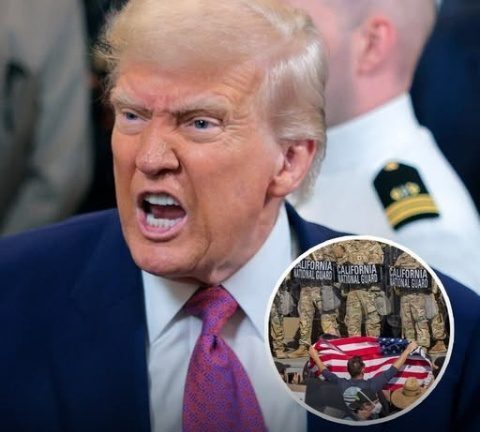Fact-checking Nayib Bukele and Trump officials on Kilmar Abrego Garcia’s deportation
Bukele and several Trump administration officials made misleading statements about Abrego Garcia’s case and the role the U.S. and El Salvador’s governments play in his potential return
President Donald Trump’s April 14 public meeting with El Salvador President Nayib Bukele centered on the mistaken deportation of Kilmar Armando Abrego Garcia. PolitiFact checks their claims.
President Donald Trump’s April 14 public meeting with El Salvador President Nayib Bukele centered on the mistaken deportation of Kilmar Armando Abrego Garcia.
Trump administration officials and Bukele said Abrego Garcia would not be returned to the U.S, four days after the U.S. Supreme Court ruled that the Trump administration must facilitate Abrego Garcia’s return.
On March 15, the U.S. government deported Abrego Garcia to CECOT, a Salvadoran mega-prison where Trump has sent hundreds of Salvadoran and Venezuelan men who were previously in the U.S. But Abrego Garcia had a protection that was supposed to prevent him from being deported to El Salvador. The Justice Department called Abrego Garcia’s deportation an “oversight” and “an administrative error” in a court filing.
During the Oval Office meeting, Bukele and several Trump administration officials made misleading statements about Abrego Garcia’s case and the role the U.S. and El Salvador’s governments play in his potential return.
Here are the facts.
Attorney General Pam Bondi: “In 2019, two courts, an immigration court and an appellate immigration court, ruled that (Abrego Garcia) was a member of MS-13.”
This needs context. U.S. Immigration and Customs Enforcement arrested Abrego Garcia in 2019 as he was looking for day labor outside a Home Depot in Maryland. A police informant told police Abrego Garcia was an MS-13 member. Immigration judges denied Abrego Garcia bond, both initially and on appeal, citing the informant’s accusation.
In the initial denial, the judge said the determination of Abrego Garcia’s gang membership “appears to be trustworthy and is supported” by evidence from the Gang Field Interview Sheet which, in part, referenced the informant. Abrego Garcia’s attorneys have repeatedly said in court that the informant’s accusation was fabricated.
The immigration judges’ decision to deny bond is not equivalent to ruling that Abrego Garcia was a gang member, David Bier, associate director of immigration studies at the libertarian Cato Institute, said.
In immigration bond hearings, detainees have the burden of proof to show they are neither a flight risk nor a danger to the community. Abrego Garcia “failed to meet his burden to show that he was not a danger,” Bier said. That’s not the same as the government proving affirmatively that he was an MS-13 member.
“The immigration judge is only taking at face value any evidence that the government provides,” Bier said. “It is not assessing its underlying validity at that stage.”
Abrego Garcia later received an immigration protection called withholding of removal. Granting that protection required the Department of Homeland Security to decide Abrego Garcia was not “a danger to the security of the United States,” Bier said, quoting U.S. immigration law.
“The Trump administration did not appeal these determinations or the granting of withholding of removal,” Bier said. “So at that time, it did not consider him a threat and no new evidence has been presented since then.”
Simon Sandoval-Moshenberg, an attorney for Abrego Garcia, told PolitiFact his client has “never been convicted of any crime, gang-related or otherwise,” and we also found no court evidence he had been convicted. Neither of the immigration court proceedings constitute a conviction, because they were not trials.
White House Deputy Chief of Staff Stephen Miller: “When President Trump declared MS-13 to be a foreign terrorist organization, that meant that (Abrego Garcia) was no longer eligible, under federal law … for any form of immigration relief in the United States.”
It’s inaccurate that the U.S. government’s February designation of MS-13 as a foreign terrorist organization automatically revoked Abrego Garcia’s protection from removal, Aaron Reichlin-Melnick, a senior fellow at the American Immigration Council, said.
People who are proven members of a terrorist organization are ineligible for protection from removal. But in Abrego Garcia’s case, to revoke his protections, the U.S. government “would have been required under law to reopen his immigration court proceedings and prove to the judge that he was a member of MS-13 and therefore no longer eligible for withholding.”
“The government certainly could have sought to prove that (Abrego Garcia) was not eligible for any form of immigration relief, but it did not do so,” Bier said.
Bukele: Returning Abrego Garcia to the U.S. would be akin to “smuggl(ing) a terrorist into the United States.”
There is no evidence that Abrego Garcia is a terrorist. As we noted above, it’s unproven that Abrego Garcia is a member of MS-13 and therefore a terrorist after the gang’s foreign terrorist designation.
Abrego Garcia is being held in a Salvadoran prison at the U.S. government’s request, not because he committed a crime in El Salvador, Reichlin-Melnick said. Therefore, Bukele could release Abrego Garcia and the U.S. government could grant him humanitarian parole “as part of the court order requiring them to facilitate his return,” Reichlin-Melnick said.

Prison guards transfer deportees from the U.S., alleged to be Venezuelan gang members, to the Terrorism Confinement Center in Tecoluca, El Salvador, March 16, 2025. (El Salvador presidential press office via AP, File)
Secretary of State Marco Rubio: “This individual is a citizen of El Salvador. He was illegally in the United States and was returned to his country. That’s where you deport people back to their country of origin.”
This is misleading. Although it’s accurate that people are generally deported to their country of origin or another country that accepts their deportation, that is not the case for Abrego Garcia. Abrego Garcia had a withholding of removal order which prevents people from being deported to their home country — in Abrego Garcia’s case, El Salvador — and allows them to legally work in the U.S. People with this protection can be deported to another country if that country accepts to take them.
In 2019, an immigration judge granted Abrego Garcia withholding of removal. The judge entered a deportation order and told the government it could not use that order to deport Abrego Garcia to El Salvador. Abrego Garcia received the protection because when he was a minor living in El Salvador, a gang had tried to recruit him and extort money from his mother, leading to death threats.
U.S. Immigration and Customs Enforcement lawyers acknowledged in a March court filing they were aware of the restriction on deporting Abrego Garcia to El Salvador and called his removal an “oversight” and “an administrative error.”
Miller: “We won (the Supreme Court) case 9-0 and people like CNN are portraying it as a loss.”
This is misleading. On April 10, the Supreme Court ruled, in an unsigned order, that the U.S. government had to “‘facilitate’ Abrego Garcia’s release from custody in El Salvador and ensure that his case is handled as it would have been had he not been improperly sent to El Salvador.”
The Supreme Court also asked the lower court to “clarify its directive, with due regard for the deference owed to the Executive Branch in the conduct of foreign affairs.” The lower court had ordered that the U.S. “facilitate and effectuate” Abrego Garcia’s release.
On April 11, the federal judge said the U.S. government had “failed to comply” with the court’s order and ordered the government to submit daily updates on Abrego Garcia’s location and what steps the government has taken to facilitate his return.






